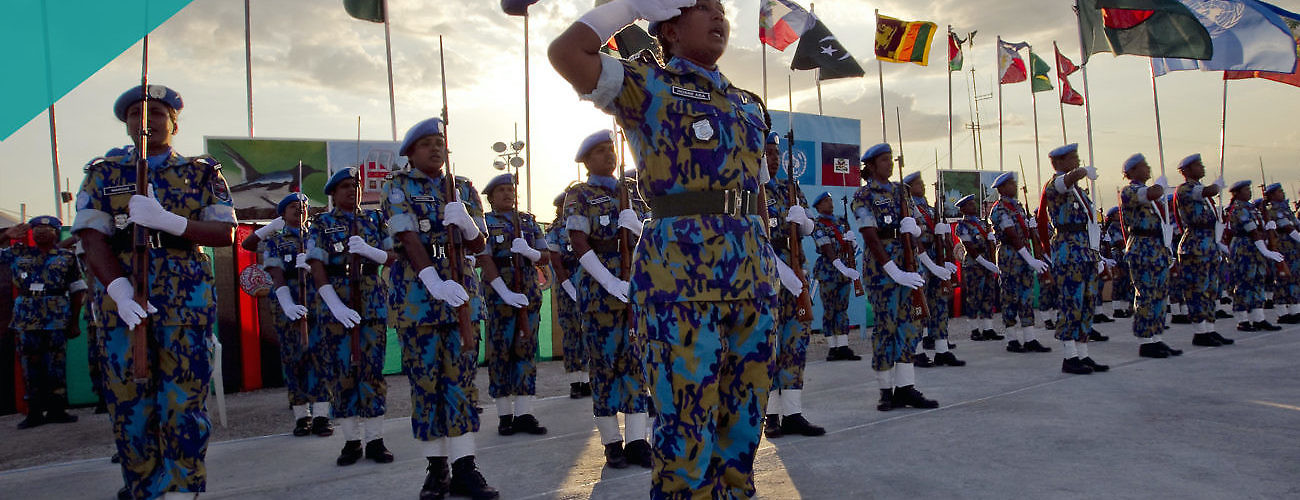Members of the Bangladeshi Formed Police Unit (FPU), the sole all-female FPU of the United Nations Stabilization Mission in Haiti (MINUSTAH), stand in salute. (UN Photo/Logan Abassi)
Since the United Nations Security Council adopted resolution 1325 on women, peace, and security (WPS), the UN has emphasized its intent to increase women’s participation in the police, military, and civilian areas of peacekeeping. Despite nearly two decades of resolutions, policies, and rhetoric related to the WPS agenda, however, women’s participation in UN peacekeeping has only modestly increased and many components of the agenda remain woefully under-addressed. Moreover, information on women in peacekeeping roles and the impact of their participation has remained overwhelmingly anecdotal.
Resolution 1325 includes a protection pillar, which highlights the unique protection needs of women and girls in armed conflict. This pillar is closely related to the UN’s protection of civilians (POC) agenda, though the POC and WPS agendas are seldom applied together in practice. Increasing women’s participation is often cited as critical for increased protection of civilians, but falls short when it comes to enacting gender-sensitive POC strategies for a number of reasons. One is reductive characterizations of women as vulnerable and men as perpetrators. Even as UN protection strategies have increasingly included gendered considerations, they still tend to rely on these binary perceptions, as well as on essentializing assumptions that women peacekeepers are inherently best placed to protect women civilians. These assumptions risk weakening POC efforts, as they perpetuate a narrow understanding of who is and who is not in need of protection.
Perpetuating these stereotypes of women is likely having an effect on women’s ability to substantially participate in peacekeeping. Anecdotal evidence from recent consultations at the International Peace Institute indicates that uniformed women are sometimes left out of deployment experiences deemed “too dangerous” for them. The DCAF baseline study supports this, pointing out that senior leadership are likely to see women as needing protection rather than “as protectors in their own right.”
If women’s participation is to actually be meaningful, pushes to increase women’s participation should move beyond gender stereotypes and “add women and stir” calls for parity. Recent consultations held at IPI have also indicated that it is difficult to collect data that backs up claims that local women are more likely to report protection concerns to women peacekeepers. Such assumptions underscore women peacekeepers’ siloing as addressing only women’s needs, rather than the entire population, which is actually their mandate.
Another reason that women’s participation has not increased substantially is that within the WPS and POC agendas, women’s protection needs are frequently reduced to a focus on sexual violence. When gendered protection has this disproportionate focus on sexual violence against women, broader definitions of gender-based violence and incidents of sexual violence against men are ignored. Additionally, other threats to women civilians outside of sexual violence are lost or under-addressed. These include the increasing dangers faced by women human rights defenders, food insecurity, displacement, and diminished access to medical resources—all direct or indirect results of the threats of physical violence that peacekeeping operations’ mandates address.
Likewise, there is evidence that women face a consistently high risk of death after conflict, while men face a higher risk during conflict. These differences highlight both the variance in gendered protection needs across time, but should also serve as a reminder that protection should entail both direct and indirect threats to people of all genders.
A third reason is that the burden of sexual and gender-based violence programming in peacekeeping operations is often placed on the women of those missions. This means that protection work for women and children is unlikely to be done otherwise, and indicates that protection from sexual violence in conflict continues to be a women’s issue, rather than a gender issue that affects all members of a civilian population. There is a great deal of violence—both sexualized and otherwise—carried out against non-women civilians, but those examples do not typically make it into mainstream discussions of gender and POC, not least because “gender” so often ends up as a stand-in term for “women.”
These assumptions fail to take into account that women peacekeepers might not always be the best positioned to address the needs of women civilians simply by merit of shared gender identity. For example, Rwandan women peacekeepers returning from deployments in the UN-African Union Mission in Darfur (UNAMID) and the UN Mission in South Sudan (UNMISS) have said that they were inadequately trained for the sexual violence response work that was expected of them. When women are assumed to be naturally—by merit of sex—equipped to address gender-specific protection concerns, leadership will not be motivated to implement specific training that prepares all peacekeepers to respond to those concerns.
Recognizing these assumptions and attempting to move beyond them is important to addressing the many gendered risks of exposure to violence. For example, the same binary that supposes women are in need of protection and are the primary victims, reinforces views of men as violent threats, which can in turn be used to exact gender-based violence against both men and boys. Men deemed “military-age” can face significant risk of state violence simply by merit of appearance. This binary framing likewise negates the interrelated protection concerns of women and men. Families that are separated by conflict—for example, if one parent leaves to join an armed group or is detained for some reason—can be at higher risk of attack or displacement.
Not considering an expansive definition of gender in protection when formulating WPS and POC interventions—including increasing women’s participation in peacekeeping—fails to address how such interventions might benefit all civilian populations. It also indicates that the UN’s strategies around this issue are still rooted in the reductive notions of gender that the WPS agenda seeks to overcome.
Gretchen Baldwin is a Policy Analyst in the Women, Peace, and Security program at the International Peace Institute, where she primarily focuses on the Women in Peace Operations research track.





